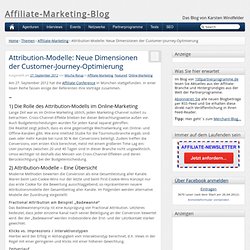

Attribution-Modelle: Neue Dimensionen der Customer-Journey-Optimierung. Am 27.

September 2012 hat die Affiliate-Conference in München stattgefunden. In einer losen Reihe fassen einige der Referenten ihre Vorträge zusammen. 1) Die Rolle des Attribution-Modells im Online-Marketing Lange Zeit war es im Online-Marketing üblich, jeden Marketing-Channel isoliert zu betrachten. Cross-Channel-Effekte blieben bei dieser Betrachtungsweise außen vor. 2) Attribution-Modelle – Eine Übersicht Moderne Methoden bewerten die Conversion als eine Gesamtleistung aller Kanäle. Fractional Attribution am Beispiel „Badewanne“ Das Badewannenprinzip ist eine Ausprägung von Fractional Attribution. Klicks vs. Zeitverlauf Dem Erfolg wird eine Zeitkomponente beigefügt. Cross-Channel-Attribution Bei dieser Art der Zuordnung werden neben den Online-Touchpoints auch Offline-Marketingkanäle wie TV-Werbung oder Telefon in die Gesamtgewichtung mit einbezogen.
Regelbasierte Attribution Weiterhin ist es möglich, individuelle, meist sehr komplexe Regeln für die Attribution zu formulieren. When does Retargeting Work? Information Specificity in Online Advertising by Anja Lambrecht, Catherine Tucker. Anja Lambrecht London Business School Catherine Tucker Massachusetts Institute of Technology (MIT) - Management Science (MS)May 6, 2013 Abstract: Firms can now serve personalized recommendations to consumers who return to their website, based on their earlier browsing history on that website.

Number of Pages in PDF File: 52 Keywords: online advertising, advertising effectiveness, retargeting, online consumer behavior, information specificity, consumer decision process JEL Classification: M3, M31, M37 working papers series Suggested Citation Lambrecht, Anja and Tucker, Catherine, When does Retargeting Work? Webinar: Multi-Channel Funnels: Attribution Across Channels. Visualizing the customer experience using customer experience journey maps. Too often when we think of a customer, our view is filtered through the lens of our job, profession, department, or specialty.

Think of how patients are treated in most hospitals. They are viewed as a disease, an illness, a collection of parts – each with its own specialist. The hospital system is designed for the convenience of the specialists, not for the needs of the patient. Specialists in a hospital are much like the silos in an organization, each viewing a customer from their own departmental lens. Bringing the outside in using customer experience journey maps Customer experience journey maps are a tool to help bring the outside world into an organization. And as we map out the customer’s story, our organization’s own story becomes visible. Below are a few examples of different types of customer experience journey maps. [updated September 28, 2011 & May 22 2012 with additional examples] Social Gamer created by nForm Lego’s WOW map for an executive’s experience visiting LEGO. Create a new Customer Journey Canvas. This tool supports the audit of existing services and covers not only the period of time associated with the encounter but also the pre-service and post-service phases of the journey.

Customer journey maps are typically focused on the front stage encounter from the customer’s point-of-view but as an audit it’d be great to see a complementary version demonstrating the connections with the back stage supporting processes. Service Design Thinking is an upcoming term that will be (or already is) going viral among businesses. The name is pretty self explanatory—it basically refers to the process of brainstorming and designing services.
The Customer Journey Canvas is a template to facilitate this process. The big deal about service design thinking is that it can help a business to stand out from its competitors by offering value-added services that will heighten customer satisfaction and develop brand loyalty. No business can go without reflections and evaluations of their services.